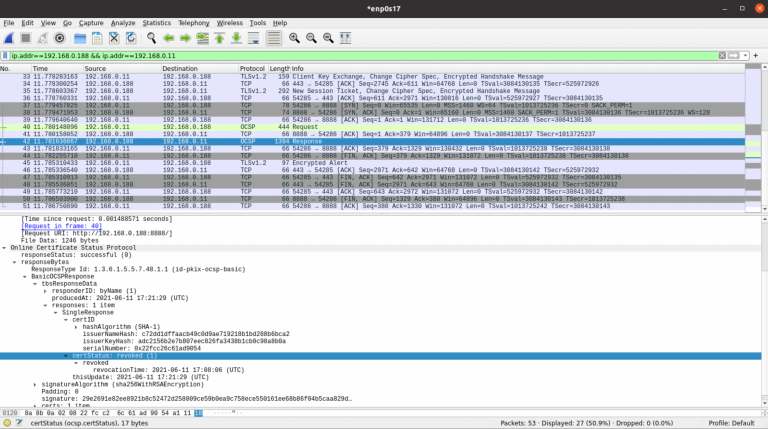
- #Openssl inspect certificate mac osx#
- #Openssl inspect certificate zip file#
- #Openssl inspect certificate windows 10#
When all is said and done, we should see a new file in our home folder. certfile IntermediateCA.crt – this is an option to read from addition certificate files. in examplevpn.crt – use this certificate. inkey privatekeySSL.pem – use this private key file. export – argument that calls for a PKCS12 to be created. pkcs12 – calls for the PKCS12 utility in OpenSSL. We want to copy those files to our home folder and our private key pem file.įrom here we can bundle our Private Key, Identity Certificate and Intermediate Certificate into a PKCS12 file for FTD upload. What is important are the files called out in red.
#Openssl inspect certificate zip file#
Once you get your Zip file this will usually contain your Identity Certificate, Intermediate Certificate, and Root Certificate. Cisco provides a good example using GoDaddy. This will show if all the attributes are correct.Īt this point you would submit the CSR to your domain registry. I’ll go to a CSR decoder website to validate the CSR files. config sancert.cnf – calls upon this configuration file for all the attributes. What this file also does is answer all those attribute questions that we saw in our first CSR file creation. To facilitate this process, I use a simple configuration file for openssl to reference.Īdd this sancert.cnf file to Cygwin home folder. What if we wanted to create a CSR with Subject Alternative Names? This creates two files a examplevpn.csr and a privatekeySSL in your Cywgin home folder. keyout privatekeySSL.pem – use the indicated privatekeySSL.pem as the private key file nodes – no not encrypt private key pem file newkey rsa:2048 – generate a new private key and certificate request using 2048 key strength

out examplevpn.csr – name certificate examplevpn.csr as Certificate Signing Request Req – certificate request and certificate generating utility in OpenSSL. Openssl req -out examplevpn.csr -newkey rsa:2048 -nodes -keyout privatekeySSL.pem Here is a breakdown of the OpenSSL commands used above. Once you have Cygwin installed and have your Terminal open type the following commands to create a Certificate Signing Request. Program like Cygwin allows you to use open source tools like OpenSSL.
#Openssl inspect certificate mac osx#
If you’re on Mac OSX or Linux you can open up a Terminal window.
#Openssl inspect certificate windows 10#
If you follow my steps, you’ll get something like the bottom trustpoint a complete certificate chain with no errors.įor the OpenSSL program that I’m using is Cygwin since I’m on a Windows 10 device. For a proper PKCS12 file all you will need is private key, identity certificate, intermediate certificate.

One common misconfiguration I see a lot in the FMC are the PKCS12 file containing private key, identity certificate, intermediate certificate and root certificate. My hope for this guide is to cut through all the confusion and get you up and running with a complete certificate chain in your FMC store. I always had problems creating CSRs with Subject Alternative Names (SAN) records. ASDM allowed us to create CSR to use for our Remote Access VPNs, but it also seemed to have limitations as well. ASDM managing your firewalls are gone when moving to the FTD platform. These FTDs in turn are managed usually by FirePower Management Center. They usually get replaced with Cisco’s FirePower Threat Defense. Choose Certificate Technical Support from the drop down menu.How to create a Certificate Signing Request with OpenSSL for your Cisco Firepower Threat Defense Firewall managed by FirePower Management Center.įewer and fewer ASA firewalls in production as time goes on.If you are unable to find the private key that corresponds to your certificate, you will need a replacement certificate. To search for all private keys on your server: You can either create a brand new key and CSR and contact support, or you can do a search for any other private keys on the system and see if they match. If the first commands shows any errors, or if the modulus of the public key in the certificate and the modulus of the private key do not exactly match, then you're not using the correct private key.

Openssl x509 -modulus -noout -in myserver.crt | openssl md5 To view the modulus of the RSA public key in a certificate: If it doesn't say 'RSA key ok', it isn't OK!" Openssl rsa -check -noout -in myserver.key Openssl rsa -modulus -noout -in myserver.key | openssl md5 To verify the consistency of the RSA private key and to view its modulus: To verify that an RSA private key matches the RSA public key in a certificate you need to i) verify the consistency of the private key and ii) compare the modulus of the public key in the certificate against the modulus of the private key.


 0 kommentar(er)
0 kommentar(er)
